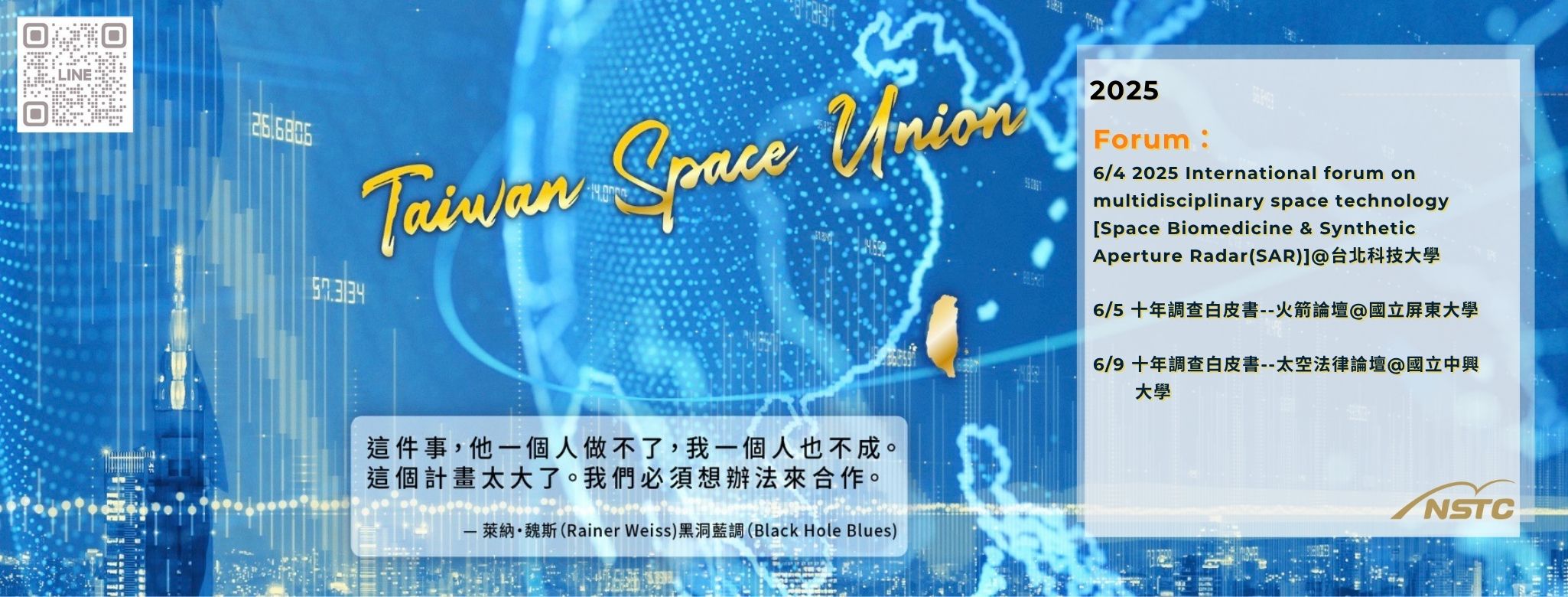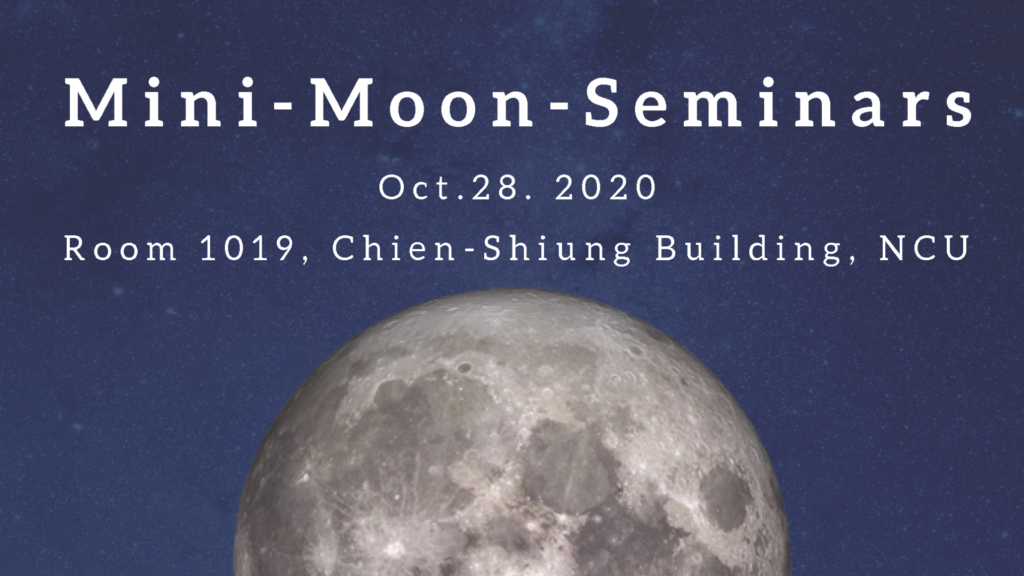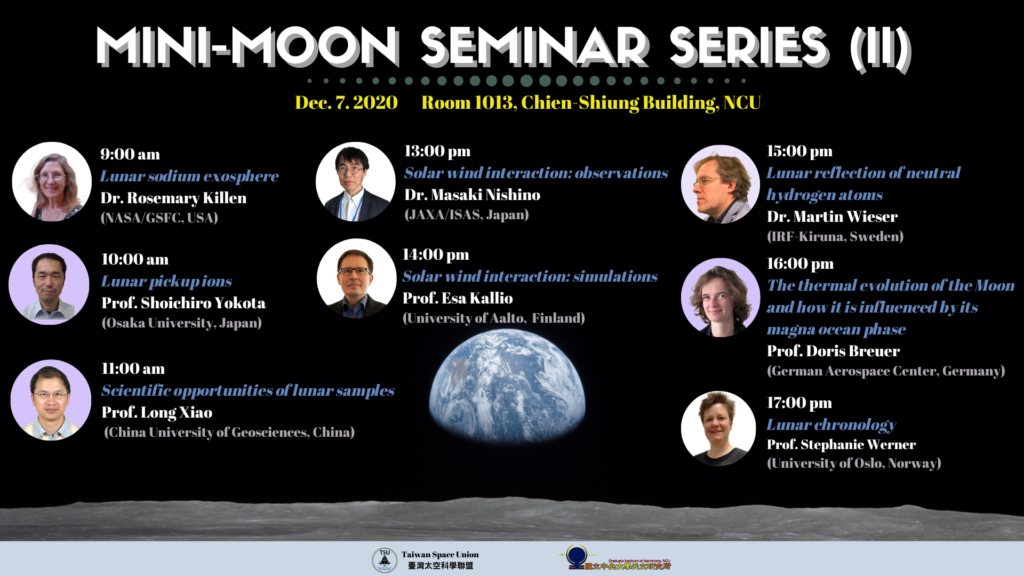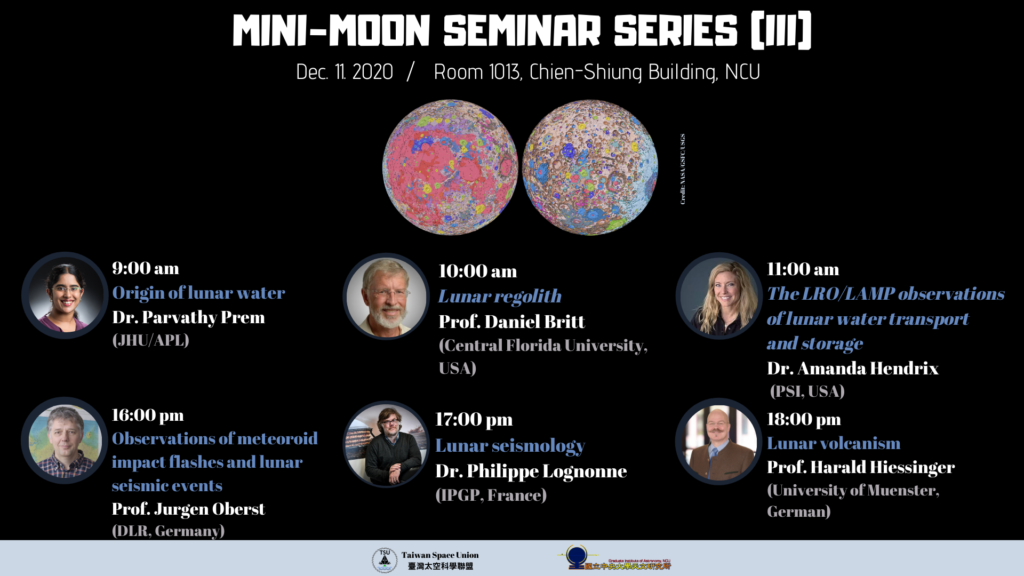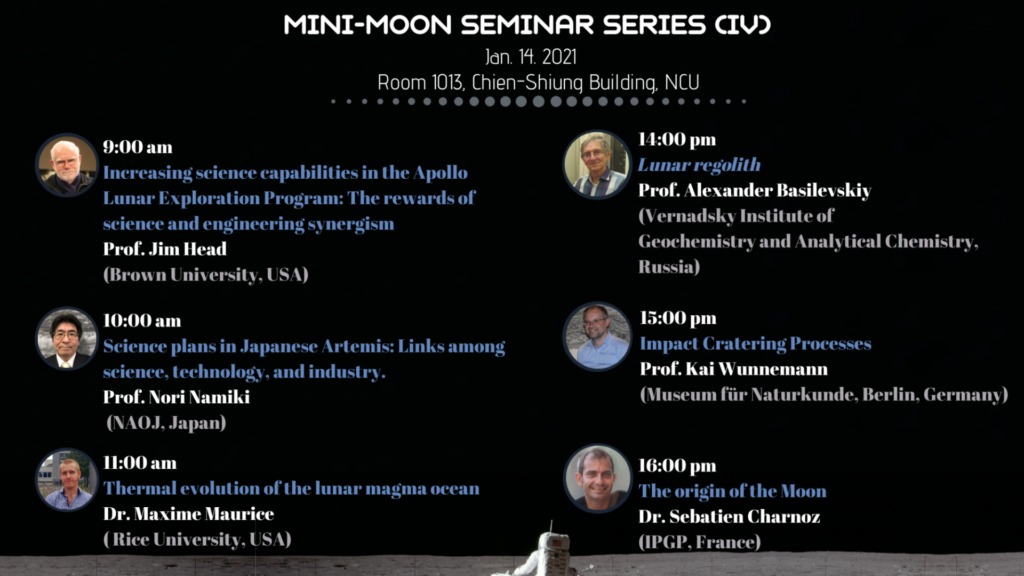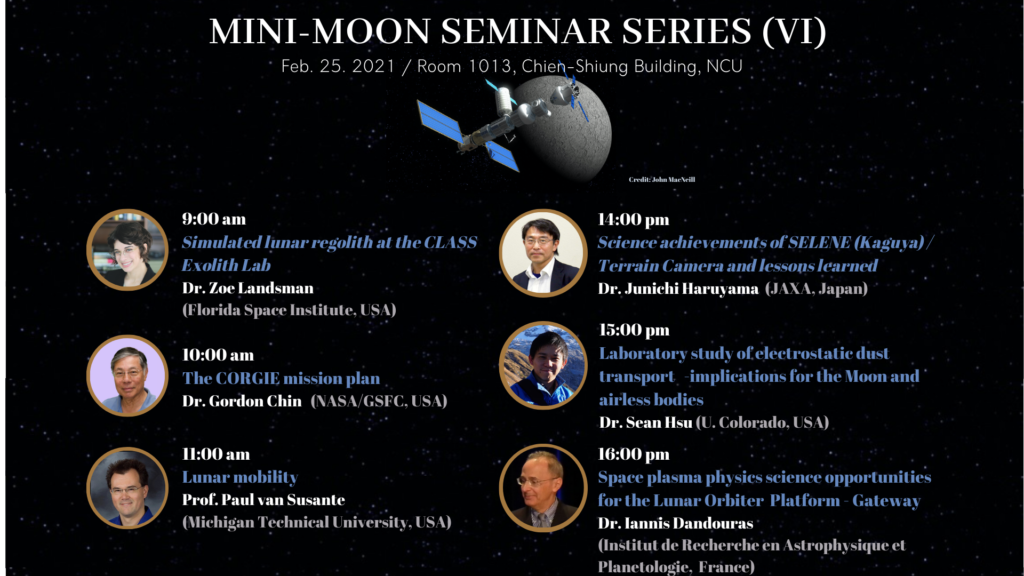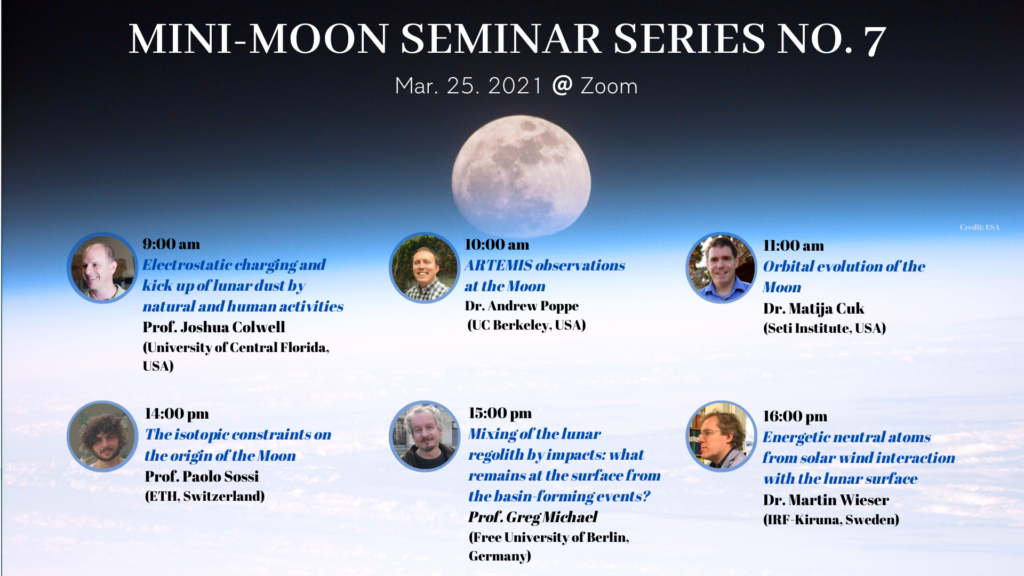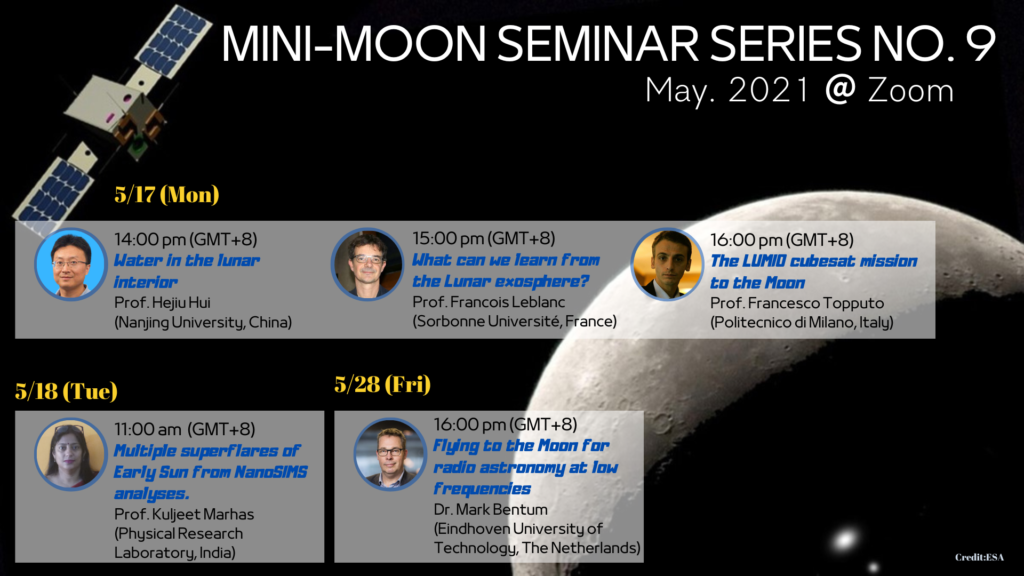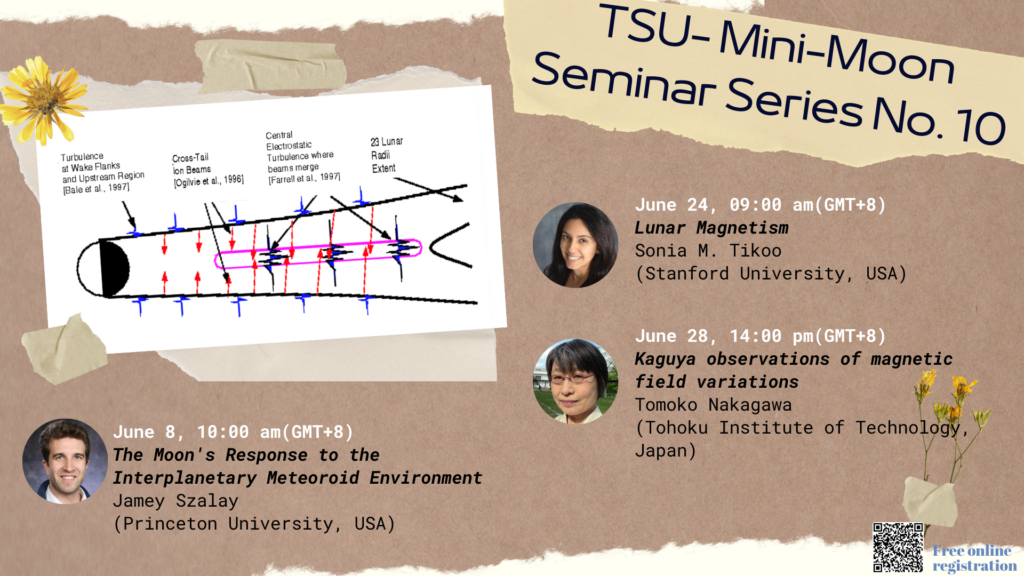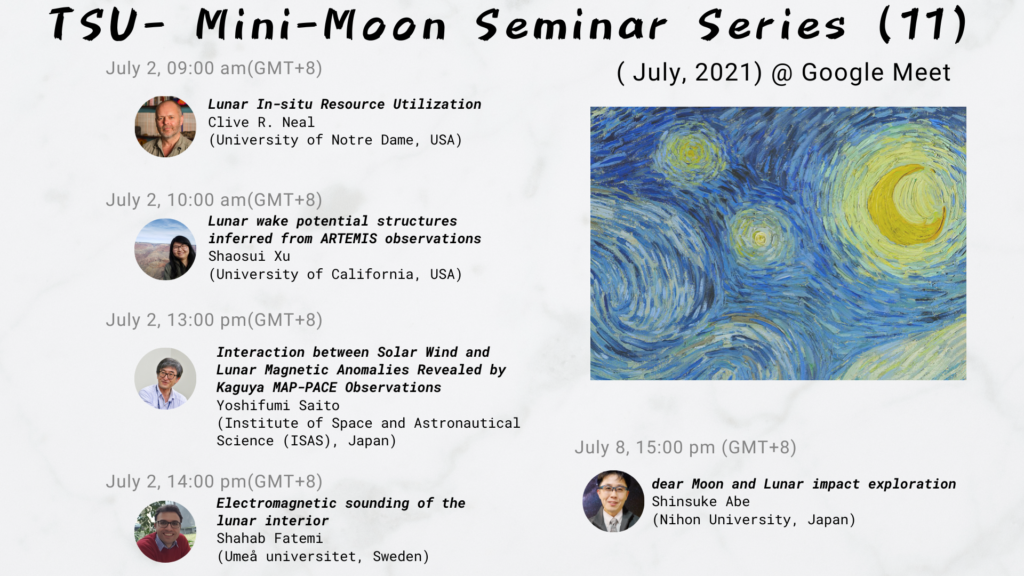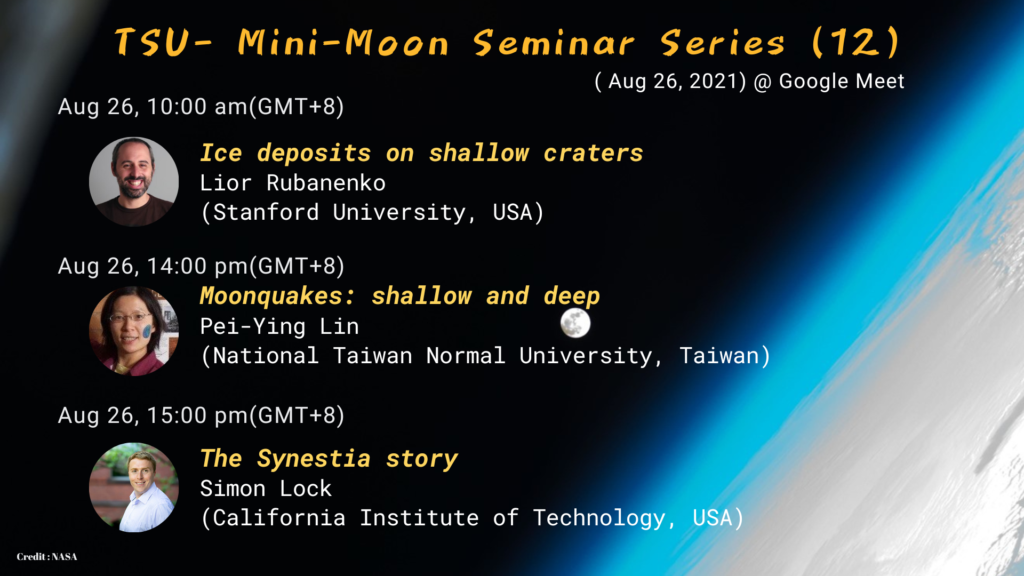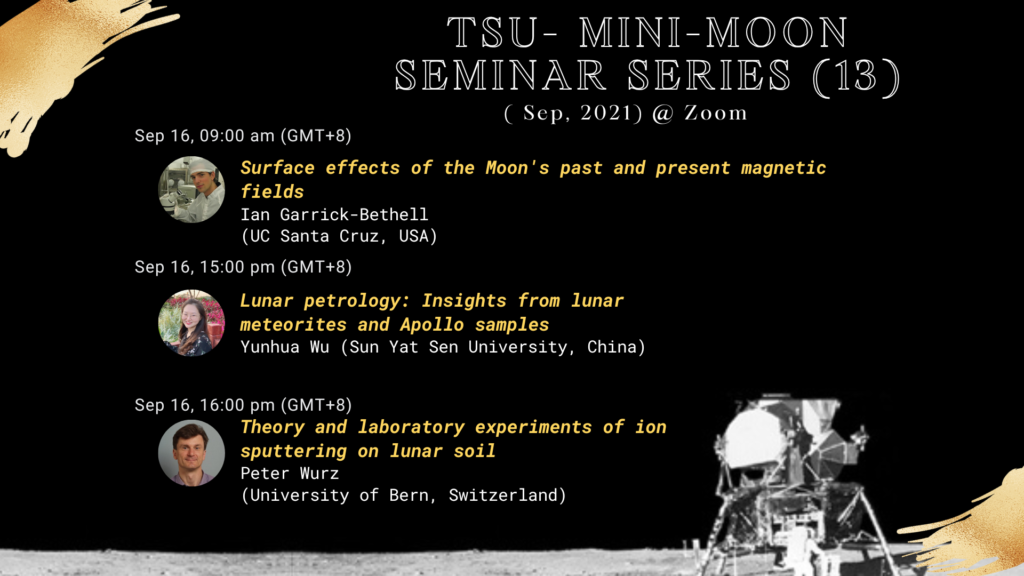從2020年10月至今,得到國際行星科學專家的協助,TSU已經舉辦了多次線上月球科學教程研討會。目的在於整理月球科學研究的基本知識,並且讓有興趣進行相關工作的同學和研究員有機會認識這些在月球研究前沿的行星科學家。有些講者非常資深(從阿波羅任務便一路打拼到今天NASA的阿提米絲(Artemis,月球門戶太空站)計畫,有的還只是剛念完博士學位,奮發有為的博士後。但從他/她們的教程講座中都可以學習到不同的科學知識和經驗,特別是領略到科學家和工程師之間互動和合作的重要性。
如果把講題大分成6類,即(1)月球電漿及大氣環境、(2)表面構造及碰撞歷史、(3)內部構造、(4)來源及演化、(5)月球任務架構、(6)其它。則有部份的教程材料尚有欠缺,我們將在未來數月中補上。但在這些教材基礎上,將陸續邀請專家講述他/她們目前在進行的第一線研究工作。
議題包含:實地資源勘測和利用(in-situ resource utilisation)、月球太空站的電漿環境和物理作用、月球岩石和塵粒標本的分析…等。這些跨領域的研究題目包括AI、材料科學、土木工程、礦物學、以致道道地地的太空物理,希望因此能夠引起更多人的興趣和製作國際合作機會。

Mini Small-Bodies Seminars
Mini Moon List
1. Lunar Environmental Study
Surface effects of the Moon’s past and present magnetic fields, Ian Garrick-Bethell (13)
Lunar Vertex: Exploration of the Reiner Gamma Magnetic Anomaly and Swirl, David Blewett(31)
Electrostatic Charging and Kick-Up of Lunar Dust by Natural and Human Ac- tivities, Joshua Colwell (7)
Space Plasma Physics Science Opportunities for the Lunar Orbiter Platform- Gateway, Iannis Dandouras (6)
The Plasma Environment of the Moon, Jasper Halekas (1)
Lunar Dust, Mihaly Horanyi (1)
Laboratory Study of Electrostatic Dust Transport – Implications for the Moon and airless bodies, Sean Hsu (6)
Electrostatic Dust Motion on Small Airless Bodies: Computational Predictions and Experimental Investigations, Christine M. Hartzell (26)
Lunar Surface Hydration: A View from Earth, Casey Honniball(34)
Lunar Exosphere History of Observations, Rosemary Killen (2)
Exosphere of Mercury and the Moon, Rosemary Killen (1)
Solar wind interaction: simulations, Esa Kallio (2)
On the Moon’s interaction with the terrestrial magnetotail lobes, Lucas Liuzzo (15)
What can we learn from the Lunar exosphere?, Francois Leblanc (9)
Lunar megaregolith mixing by impact: how does the material composition evolve with time?, Tiantian Liu(30)
Measuring Water Vapor at the Moon, Timothy Austin Livengood(33)
A Brief Discussion on Electrostatics of The Moon, Sanjay Mishra (5)
Kaguya observations of magnetic field variations, Tomoko Nakagawa (10)
Solar wind interaction: observations, Masaki Nishino (2)
ARTEMIS mapping of lunar crustal magnetic reflection of solar wind protons, Andrew Poppe (7)
Interaction between Solar Wind and Lunar Magnetic Anomalies Revealed by Kaguya MAP-PACE Observations, Yoshifumi Saito (11)
The Moon’s Response to the Interplanetary Meteoroid Environment, Jamey Szalay (10)
The Lunar Sodium Exosphere, Carl Schmidt(31)
Coupled H, H2, OH, and H2O lunar exosphere simulation framework and impacts of conversion reactions, Alexander Smolka(35)
Theory and laboratory experiments of ion sputtering on lunar soil, Peter Wurz (13)
Energetic Neutral Atoms from Solar Wind Interaction with the Lunar Surface, Martin Wieser (7)
Lunar wake potential structures inferred from ARTEMIS observations, Sha- osui Xu (11)
Lunar pickup ions, Shoichiro Yokota (2)
Lunar Dust Experiments – What can they tell us about life on the Moon?, Li Hsia Yeo (38)
Science through energetic charged particles at the Earth’s moon (and beyond), Elias Roussos (41)
2. Lunar Surface and Geological Processes
Observation and interpretation of lunar impact flashes, Chrysa Avdellidou (8)
Dear Moon and lunar impact exploration, Shinsuke Abe (11)
Lunar geology: History of studies and problems to resolve in future missions, Alexander Basilevsky (4)
The lunar regolith, Daniel Britt (3)
Subsurface structure of the Moon at the Chang’E-3 landing site as Seen by the Lunar Penetrating Radar, Wenzhe Fa (5)
Science Achievements of SELENE / Terrain Camera (with Lessons Learned), Junichi Haruyama (6)
Lunar volcanism, Harald Hiessinger (3)
Diurnally Migrating Water on the Moon: evidence from LRO LAMP, Amanda Hendrix (3)
A decade of discovery – observing a changing Moon with the Lunar Recon- naissance Orbiter, John Keller (8)
Lunar Simulants at CLASS Exolith Laboratory, Zoe Landsman (6)
Neliota: The Long Term Monitoringn Campaing for Lunar Impact Flashes, Alexios Liakos(32)
Mixing of the lunar regolith by impacts: what remains at the surface from the basin-forming events?, Greg Michael (7)
The present-day meteoroid flux on the lunar surface – from recordings of seis- mic impact events, observations of impact flashes, and statistics of fresh cra- ters, Jurgen Oberst (3)
Global lunar mineralogy, Carle Pieters (5)
Origins of Lunar Water, Parvathy Prem (3)
Transient Lunar Atmospheres, Parvathy Prem (5)
On the Origin of Ice on the Moon and Mercury, Lior Rubenenko (12)
New insights of rock erosion on the Moon: degradation, fragmentation and micro-flaking, Ottaviano Ruesch (25)
Lunar Cold Traps and Subsurface Vapor Diffusion, Norbert Schorghofer (14)
The LUMIO CubeSat Mission to the Moon, Francesco Topputo (9)
Evolution of the Lunar Interior Caused by Migrating Magma in a two-dimensional annular Mantle, Kenyo U(29)
Lunar chronology, Stephanie Werner (2)
Impact cratering processes, Kai Wunnemann (4)
Lunar petrology: Insights from lunar meteorites and Apollo samples, Yunhua Wu (13)
Lunar crater chronology: Perspective from an outlier, Zhiyong Xiao (8)
The Past, the Present, and the Future of Lunar Impact Flash Observations, Masahisa Yanagisawa (27)
Exploration of the Moon’s silicic volcanism at the Gruithuisen Domes, Kerri Donaldson Hanna (39)
Lander and Rover Interactions with Lunar Regolith, Adrienne Dove (40)
Water on the Moon: what we learned and will learn from China’s Chang’e missions, Yang Liu (42)
Automated detection of lunar craters using machine learning techniques, Petr Pokorny (44)
Lunar Volatiles, Dana Hurley (45)
3. Internal Structure
Electromagnetic sounding of the lunar interior, Shahab Fatemi (11)
Lunar seismology: Start and possible next step of planetary seismology, Philippe Lognonne (3)
Moonquakes: shallow and deep-deciphering the plantary interiors, Pei-Ying Lin (12)
Lunar Magnetism, Sonia M. Tikoo (10)
An overview of results from NASA’s Lunar gravity mapper mission GRAIL, Mark Wieczorek (1)
Insights into lunar impact basins from GRAIL observations, Daniel Whal (8)
Astronomical exploration of the Outer Solar System, Fumi Yoshida (28)
Imaging the subsurface structures of a planet, Jinhai Zhang (43)
4. Origin and Evolution
The thermal evolution of the Moon and how it is influenced by its magma ocean phase, Doris Breuer (2)
Origin of the Moon following a giant impact, Sebastien Charnoz (4)
Origin of the Moon and Early Degasing?, Sebastien Charnoz (5)
Orbital evolution of the Moon, Matija Cuk (7)
Water in the lunar interior: Dustribution and Evolution, Hejiu Hui (9)
Isotopic Cosmochemistry: From the solar accretion disk to the Moon forming giant impact, Thomas Kruijer (8)
Where was the Moon? A fresh look at the early tidal evolution of the Earth-Moon system, Jun Korenaga(36)
The formation of the Earth and Moon: The synestia story, Simon Lock (12)
Thermal evolution and crystallization of the lunar magma ocean, Maxime Maurice (4)
Chemical and isotopic constraints on the origin of the Moon, Paolo Sossi (7)
The role of impact processes in the formation and evolution on the evolution of the Earth-Moon system, Kai Wünnemann (5)
5. Mission Descriptions
EXPERIMENT ON THE MOON: Lunar Payload Mission, Bassam Alfeeli (24)
Flying to the Moon for radio astronomy at low frequencies, Mark Bentum (9)
CORGIE: Confirming Orbital Remote-sensing with Ground Information Ex- periments for NASA’s PRISM PROGRAM, Gordon Chin (6)
Increasing Science Capabilities in the Apollo Lunar Exploration Program: the Rewards of Science and Engineering Synergism, Jim Head (4)
Science plans in Japanese Artemis: links among science, technology, and in- dustry, Nori Namiki (4)
Lunar In-situ Resource Utilization, Clive R. Neal (11)
Lunar Mobility, Paul van Susante (6)
Small luna lander ”SLIM for the pinpoint landing, Shinichiro Sakai (37)
Scientific opportunities of lunar samples from Chang’se-5 mission, Long Xiao (2)
6. Small Bodies
Internal structure of (small) asteroids, Adriano Campo Bagatin (21)
Long-term measurements of the erosion and accretion of dust deposits on comet 67P/Churyumov–Gerasimenko with the OSIRIS instrument, Pamela Cambianica (22)
Where is the Water? Recent Studies of Carbon Monoxide-Rich Comets, Martin Cordiner (23)
Need for a strengthened multi-disciplinary approach in asteroid science in the Gaia era, Alberto Cellino (16)
Reconstruction of asteroid shapes and spin states from photometry and disk-resolved data, Josef Durech (18)
The Transneptunian Belt – Past, Present and Future, Julio Ángel Fernández (16)
Rosetta plunging in the protoplanetary disk, Marco Fulle (17)
Plasma environments of comets: an unusual plasma laboratory, Charlotte Götz (21)
NASA’s New Horizons (NH) Mission Explores the Kuiper Belt, Carey Lisse (19)
Studies of Neptune Trojan from Ground-based Observations, Edward Lin (19)
The exploration of asteroids: lessons learned from previous missions and the ESA Hera, Patrick Michel (18)
Weathering of Phobos’ surface by Martian atmospheric ions, Quentin Nénon (20)
Physics of Cometary Nuclei – from Giotto to Rosetta, Keller Horst Uwe (17)
On the surface properties of asteroids, Xiaojing Zhang (19)
